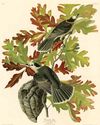
I HAVE CHERISHED a good number of trees over the years. Some I have planted myself in my yard and others belong to neighbors, strangers, parks and public forests. I'll gladly drive a longer route home just to see if a certain flowering magnolia in town has begun blooming in late April, or if an old sugar maple near the high school is displaying its usual fall fire, with some leaves as orange as the skin on a good Halloween pumpkin.
There is a sprawling sycamore tree in Providence's Roger Williams Park under which my mother had a picture taken before I came along.
My siblings and I once sat on one of its low-hanging branches, as did my children. One day soon I'll visit that tree with my grandchildren. I'm sure that it won't much matter to them when I point out the eye-catching multi-colored patchwork bark or tell them that they are at least the fourth generation of the family to sit under that tree. But it might someday.
If you love trees as I do, you certainly find it incomprehensible how some people can maliciously damage or kill one on a whim or for spite. When I heard that vandals in faraway England had, on September 28, 2023, cut down the beloved Robin Hood tree, also known as the Sycamore Gap tree, my head ached, as did so many heads and hearts around the world.
The tree had gained notoriety in Kevin Costner's movie Robin Hood: Prince of Thieves. For some 300 years it had kept watch over Hadrian's wall, the Roman Empire's boundary separating Roman Brittania and the unconquered, "uncivilized" areas to the north, in what is now Scotland.
That the uncivil perpetrators have been caught and will certainly be punished is of little consolation, for this living heirloom cannot be restored to its former state in the lifetime of anyone now walking the earth.
Denne historien er fra March - April 2024-utgaven av Horticulture.
Start din 7-dagers gratis prøveperiode på Magzter GOLD for å få tilgang til tusenvis av utvalgte premiumhistorier og 9000+ magasiner og aviser.
Allerede abonnent ? Logg på
Denne historien er fra March - April 2024-utgaven av Horticulture.
Start din 7-dagers gratis prøveperiode på Magzter GOLD for å få tilgang til tusenvis av utvalgte premiumhistorier og 9000+ magasiner og aviser.
Allerede abonnent? Logg på

Pot It Up
Shake up the containergarden with theseNorth America –native perennials

THE GARDEN PATH TO PERDITION
I WAS CRUISING RIGHT ALONG, feeling okay about myself, when I came across a list of the Seven Deadly Sins.

A Productive PATIO
Tiny fruit, vegetable and herb plants help gardeners maximize any sort of growing space

TROPICAL FUSION
A FUSS-FREE APPROACH TO USING BOLD TROPICAL PLANTS IN ANY TEMPERATE GARDEN

WINTER READING
Pass the time with any of these inspiring books

SENSING A PATTERN
Greg Coppa reflects on an odd weather year and what continued warming may mean for his Rhode Island garden

TOP-PRIZE PERENNIALS
A foliage masterpiece for shade and a late bloomer for sun

MARK WESSEL
What's new for fruit and vegetable gardeners?

KINGS OF THE NORTHERN FORESTS
A look at the trees, shrubs and perennial plants that bolster life in Ecoregion 5

PROJECT FEEDERWATCH
Gardeners can help scientists know just where the birds are in winter